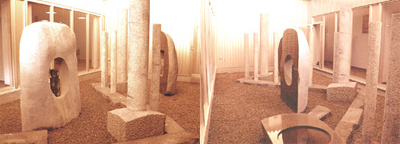Embracing Complexity in Art

Once upon a time, I was a willing and highly obedient student of modern art. I examined contemporary art trends in meticulous detail, tracing them from their origins the late nineteenth century, paying particular attention to the postwar art movements of the United States.
At that time, I was driven by a burning desire to define my work in relation to contemporary art phenomena. I felt an intense need to unlock the existential promises contained by modern art: The promise that art could be used as a vehicle for organizing human consciousness and delivering the human mind to a full understanding of space, time, and human life.
I left Japan in the 1970’s, convinced that this secret formula was hidden in the cultural centers of the modern art world. I spent the greater part of that decade in Europe and the United States, determined to wrap my mind around this problem so that I could embark on my own art career in earnest.
But instead of answers, I just found more confusion and disarray.
I had honestly thought that my studies abroad would enable me to reach a moment of breathless simplicity, in which the complication and self-conflict that surround contemporary art would simply evaporate, and I would be left with concrete answers about the meaning of human existence. But that goal seemed more distant than ever before. No matter how hard I tried, I still found contemporary art all but illegible.
Fortunately, at that point, I knew enough about contemporary art to begin to understand that this confusion was not simply a reflection of my cognitive shortcomings. Gradually, I became aware that my disorientation was actually a fairly accurate observation of the current situation: Contemporary art was struggling with a violent, prolonged episode of self-doubt.
It was as if contemporary art had lost its place on the map of self-awareness. Contemporary art had hit a dead end -- nihilism -- and it no longer made sense. By embracing Minimalism (which I consider to be a variation of nihilism) contemporary art had exposed itself as an alchemist’s dream.
We live in an infinite universe, and our relationship with it is more transient and complex than we can possibly imagine. Trying to make sense of this chaos is quite natural. It’s only human to want to understand how we fit into the world.
But attempting to do this by translating the infinite into the cynically finite is just as implausible as the idea that lead can be changed into gold.
By stripping away spirituality, human expression, and complication, and replacing them with rationality and cold symbolism, Minimalism succeeded only in creating a kind of novelty product: an extremely narrow lens which allows you to fool yourself into thinking that the world is understandable.
With the arrival of Minimalist and Conceptual art, many people began to realize (at least on an intuitive level) that contemporary art as a whole was heading in a dangerously rational direction.
This was the situation in which I found myself during the defining phase of my artistic career. And as shaky as this foundation was, I still had to address the challenge of framing my own creative impulses in relation to contemporary art. One way or another, I had to define and communicate my ideas in somewhat understandable terms, somewhere along the spectrum of what we call art.
Faced with the option of abandoning art altogether, I chose instead to direct my energies to refuting the idea that art was capable of creating a system of symbols that could allow the individual to conceive of infinity (or nature) on a rational level.
Still, a larger problem remained: What would I create? How could I make objects which would bear mute witness to the limitations of language and symbolism? How could I escape the supreme irony that confronts anyone who wishes to communicate the idea that infinity is impossible to describe?
Almost thirty years have passed since I first asked myself this question, and it is still almost as perplexing as the day it first crossed my mind.
The problem is further compounded by the fact that any sculptural object is almost automatically categorized by the viewer as a somewhat conceptual or symbolic element. Modern art has, in many ways, prejudiced its audience by establishing a strong precedent for an intellectual understanding of creativity.
But understanding the complexity of life is a contradiction in terms, since we understand our world through a process of focus. To grasp the meaning of life’s complexity, we must refuse to understand it, and instead lose our thoughts and ourselves inside it.
My work as a sculptor is an attempt to move beyond the blindness of rational understanding in search for a clearer view of life. That is my intent, in any case.
As for the objects that result from this process, I can only classify them as prototypes; as experimental objects which are meant to be directly experienced by the viewer on a very intuitive, physical level. There is no subtext associated with these objects, other than a simple reminder that logical thought is quite often a trap.
My work invites the viewer to surrender rationality; to let go of the idea that the rational mind is even remotely qualified to re-write our intuitive experience of the infinite.
The cosmos defies logic. It defies rational understanding. To surrender logic completely is to lose one’s place in the mainstream of life; but to surrender instinctual understanding is to lose one’s place in the universe.
What is the meaning of life? I can’t answer that. My art can’t answer that. I am not sure anybody can answer that. I am sure of one thing, though; and this conviction is my primary motivation for continuing to create art: The human soul cannot survive without some sense of universal identity.
When we use logic to divorce ourselves from nature, the cosmos appears as some terrifying Other, hungry for disorder and ruin, completely unconcerned with its fragile inhabitants. And although the machinations of reason may provide us with a makeshift shelter from the bewildering randomness of the universe, this is at best a self-deception about our true identity.
When we clothe ourselves in pure logic, we can enter the universal mystery only as trespassers. But when we abandon this logic, this sense of other-ness in relation to the universe, we come to realize that we are nothing less than its natural-born children.
Subscribe
I will email you when I post a new article.


